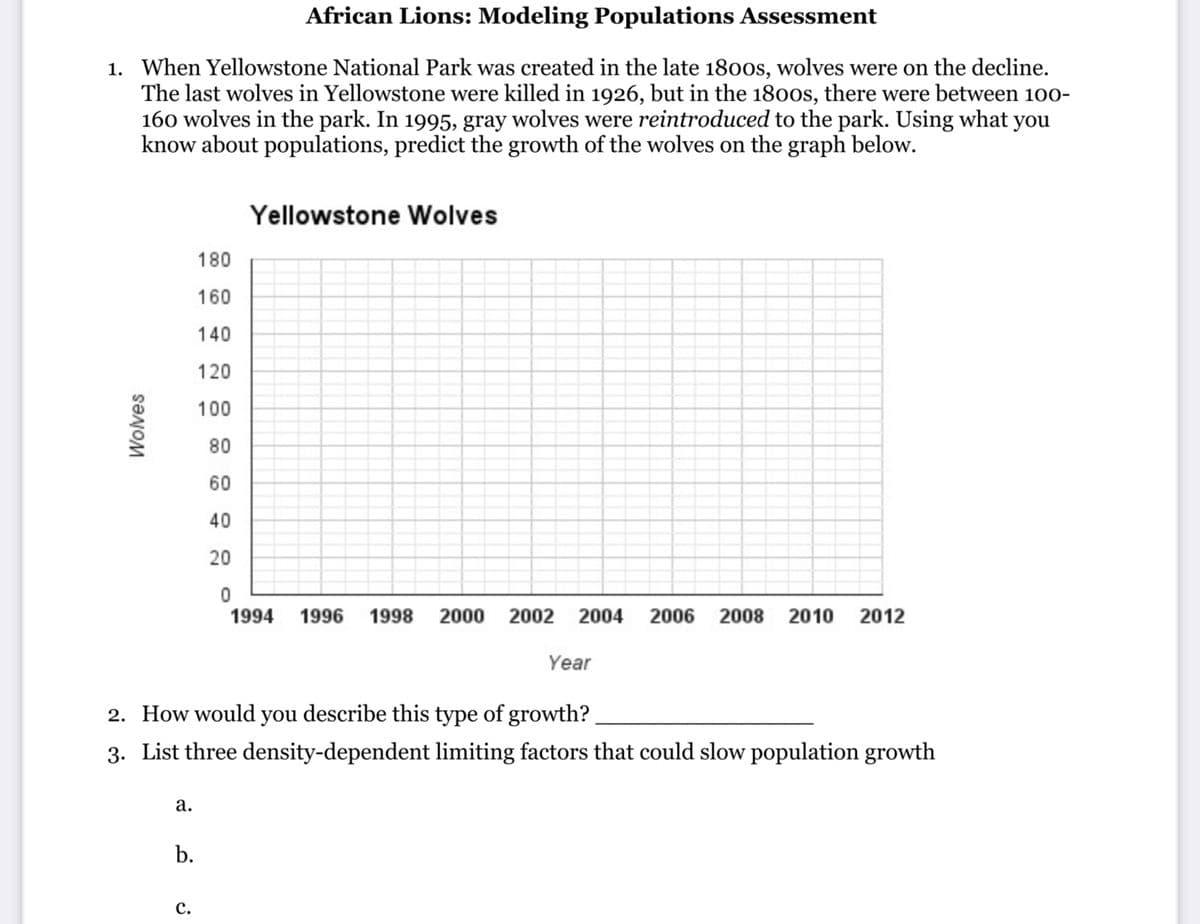1. When Yellowstone National Park was created in the late 1800s, wolves were on the decline. The last wolves in Yellowstone were killed in 1926, but in the 1800s, there were between 100- 160 wolves in the park. In 1995, gray wolves were reintroduced to the park. Using what you know about populations, predict the growth of the wolves on the graph below. Wolves a. b. Yellowstone Wolves C. 180 160 140 120 100 80 60 40 20 0 1994 1996 1998 2000 2002 2004 2006 2008 2010 2. How would you describe this type of growth? 3. List three density-dependent limiting factors that could slow population growth Year 2012
1. When Yellowstone National Park was created in the late 1800s, wolves were on the decline. The last wolves in Yellowstone were killed in 1926, but in the 1800s, there were between 100- 160 wolves in the park. In 1995, gray wolves were reintroduced to the park. Using what you know about populations, predict the growth of the wolves on the graph below. Wolves a. b. Yellowstone Wolves C. 180 160 140 120 100 80 60 40 20 0 1994 1996 1998 2000 2002 2004 2006 2008 2010 2. How would you describe this type of growth? 3. List three density-dependent limiting factors that could slow population growth Year 2012
Biology 2e
2nd Edition
ISBN:9781947172517
Author:Matthew Douglas, Jung Choi, Mary Ann Clark
Publisher:Matthew Douglas, Jung Choi, Mary Ann Clark
Chapter11: Meiosis And Sexual Reproduction
Section: Chapter Questions
Problem 17RQ: Hydras and jellyfish both live in a freshwater lake that is slowly being acidified by the runoff...
Related questions
Question

Transcribed Image Text:African Lions: Modeling Populations Assessment
1. When Yellowstone National Park was created in the late 1800s, wolves were on the decline.
The last wolves in Yellowstone were killed in 1926, but in the 1800s, there were between 100-
160 wolves in the park. In 1995, gray wolves were reintroduced to the park. Using what you
know about populations, predict the growth of the wolves on the graph below.
Wolves
a.
b.
Yellowstone Wolves
2. How would you describe this type of growth?
3. List three density-dependent limiting factors that could slow population growth
C.
180
160
140
120
100
80
60
40
20
0
1994 1996 1998 2000 2002 2004 2006 2008 2010 2012
Year
Expert Solution
This question has been solved!
Explore an expertly crafted, step-by-step solution for a thorough understanding of key concepts.
This is a popular solution!
Trending now
This is a popular solution!
Step by step
Solved in 2 steps with 1 images

Knowledge Booster
Learn more about
Need a deep-dive on the concept behind this application? Look no further. Learn more about this topic, biology and related others by exploring similar questions and additional content below.Recommended textbooks for you

Biology 2e
Biology
ISBN:
9781947172517
Author:
Matthew Douglas, Jung Choi, Mary Ann Clark
Publisher:
OpenStax

Biology Today and Tomorrow without Physiology (Mi…
Biology
ISBN:
9781305117396
Author:
Cecie Starr, Christine Evers, Lisa Starr
Publisher:
Cengage Learning

Biology: The Unity and Diversity of Life (MindTap…
Biology
ISBN:
9781337408332
Author:
Cecie Starr, Ralph Taggart, Christine Evers, Lisa Starr
Publisher:
Cengage Learning

Biology 2e
Biology
ISBN:
9781947172517
Author:
Matthew Douglas, Jung Choi, Mary Ann Clark
Publisher:
OpenStax

Biology Today and Tomorrow without Physiology (Mi…
Biology
ISBN:
9781305117396
Author:
Cecie Starr, Christine Evers, Lisa Starr
Publisher:
Cengage Learning

Biology: The Unity and Diversity of Life (MindTap…
Biology
ISBN:
9781337408332
Author:
Cecie Starr, Ralph Taggart, Christine Evers, Lisa Starr
Publisher:
Cengage Learning

Concepts of Biology
Biology
ISBN:
9781938168116
Author:
Samantha Fowler, Rebecca Roush, James Wise
Publisher:
OpenStax College